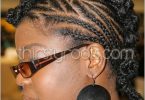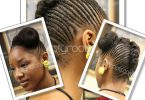Although a wide variety of cornrow updo hairstyles are common today, they are a very old hairstyle practice. Historical evidence shows that tribes that were native to Africa, Egypt, and Nigeria all displayed knowledge of hairstyling practices that are very similar, if not identical, to those that you are familiar with today. There are hieroglyphs and sculptures that show evidence of this as early as 500 B.C. and you can even find tight braids coming down from the head of the Sphinx in Egypt.
The process for making these hairstyles is time consuming and very painstaking. After all, every hair on the scalp is braided and shaped to form unique and intricate designs. Typically, the technique is to use an upward and underhand motion as you braid them. Traditionally, each style was more designated towards a particular tribe or people, so that by their hair you could recognize where they came from. Also, some regions might have included shells or beads in their designs, depending on their location, or course.
While this process is indeed very lengthy, even under the most skilled hands, it is certainly worth it. A good cornrow is a display of artistry and culture. It can show your own individuality or the particular skillset of the person who made them for you. They are also actually quite practical, as you can wash them like normal hair and leave them in for nary a month. It is usually also recommended that you apply oil to the hair and scalp every so often, to prevent them from drying out, but there is no specialty care necessary.
These hairstyles saw a major surge in popularity coming out of the Black Pride and Civil Rights movements of the 1960’s. As African Americans became more aware of their cultures there was a tendency to try to embrace as much of history as possible. One way that this was done was through the wearing of more traditional and natural hairstyles from historical context.
Out of this cultural revival came a new awakening that led to the development of African American businesses that shared this culture and passion while also capitalizing on the trends. Beauty salons allowed black Americans to own smaller businesses where they could share their cultures and traditions with other people of similar heritage and interests. Of course, you can now find many of these types of businesses all over America, with more and more people wearing these hairstyles.






